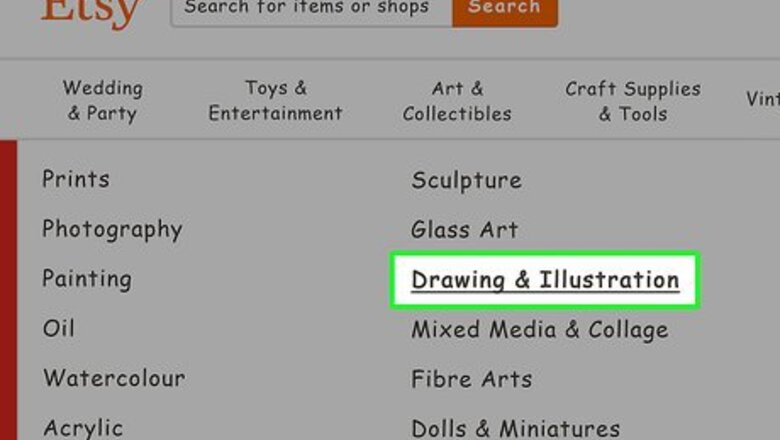
views
Selecting Artwork for the Shop
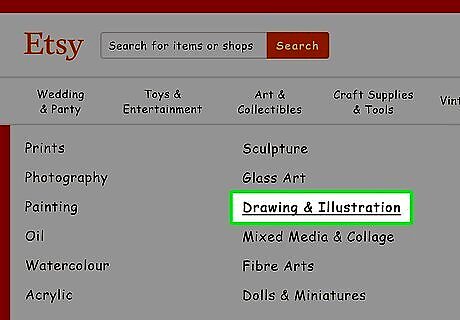
Look at what your competitors are selling and making. Spend some time looking at different Etsy sellers, especially successful ones, to find your niche in the market. Think about how your artwork can stand out from the crowd. Consider how your work is different and how you can bring a unique perspective to what is already selling on Etsy. For example, you may use the Etsy search bar to look up sellers who are making artwork that is similar to yours. You may notice what types of artwork they sell as well as their price points and their type of clientele.

Pick artwork that is unique and appealing to a specific customer. Consider the age group and demographic you want to sell to. Are you trying to make artwork for a younger audience, such as children? Do you want to make artwork for an older audience, such as individuals looking for artwork for their homes or offices? Think about how you can appeal to a specific customer or niche on Etsy. For example, you may try doing animal portraits in cross stitch, rather than paint animal portraits, as these are already popular on Etsy. Or you may create custom abstract art for interiors in interesting materials like spray paint and fabric to stand out.
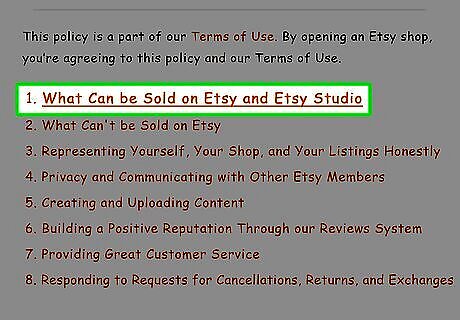
Make sure your artwork meets Etsy standards. For your artwork to be sold on Etsy, it must be handmade and/or designed by you. If you have a design partner, you must disclose this on your shop. You will also need to disclose every person involved in the making of the item. You cannot resell items that were not handmade or designed by you. You must be honest and forthcoming in your descriptions of items and in the information you provide about your shop.

Have artwork at different price points. Appeal to a variety of shoppers by carrying artwork that ranges in price. Try to have artwork that is on the more affordable side and on the more expensive side. Giving variety can open up your shop to a wide range of buyers and encourage your customers return to buy more. Etsy finds that items $50 USD and under tend to be the most popular. You may use $50 USD as your base price and price your items up or down from there. For example, you may have several pieces that are in the $50-$100 USD range or in the $0-$50 USD range. You may then offer a few larger or more detailed pieces in the $100-$200 USD range. Do not be afraid to offer artwork that is more expensive, as some art buyers are drawn to more expensive work that is original and one of a kind.
Setting up Your Etsy Shop
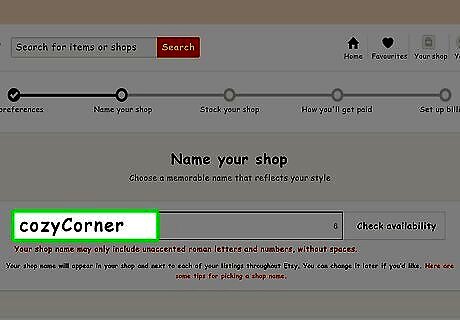
Pick a name for the shop. Choose a name that is short and memorable. The name should express what your shop is about and what type of artwork you sell. It may also refer to your location or where you are from. You may include the medium of your artwork in the name. For example, you may choose a name like "Detroit Ceramics" or "Alberta Paints." You can also use your name in the title, such as "Mindy's Cross stitch" or "Sculpture by Sean."
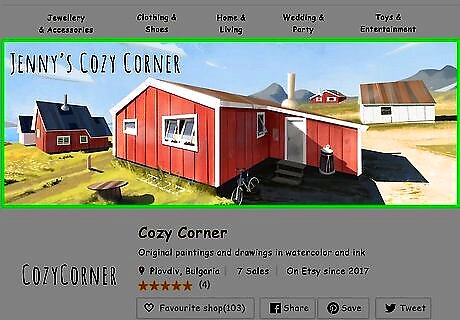
Make a professional looking banner and icon. Design a banner for your Etsy shop that is polished and well made. Use Adobe Photoshop or a photo editing program like Canva.com. Make sure the banner and icon will fit on Etsy and look nice on their site. For example, you may use text and graphics that fit the name of your Etsy shop. You can also design a custom logo or icon for the shop that you use to brand your artwork.

Fill out key details about your shop. Do this within a few days to one month of launching the shop. A detailed shop will impress customers and let them know you are legitimate. Make sure you fill out details like: Your location Your About section Your shop announcement Your shop policies Your return and refund policy Your shipping and processing times Your Frequently Asked Questions (FAQ)
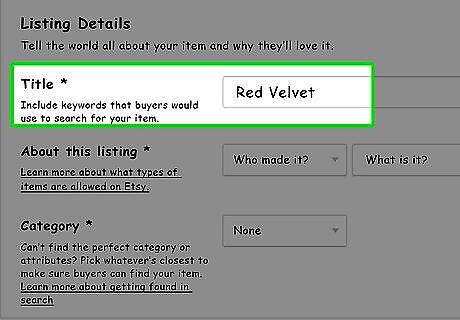
Write detailed descriptions for each item. Include descriptions that tell buyers exactly what they are getting when they purchase the item. Try to cover basic questions the buyer may have, as this will make purchasing the item easier. Your descriptions should include: The title of the artwork The dimensions of the artwork The medium(s) used to make the artwork Whether the artwork is an original or a print Whether the artwork is signed and numbered on the back or front Whether the artwork comes with a certificate of authenticity How to display the artwork How to care for the artwork How the artwork will be shipped

Use high quality photos of your art. Take pictures of your artwork in natural light with an empty background. Make sure you color correct any scanned photos so they appear as close to the original artwork as possible. Check that thumbnail photos for your items are clear and high quality. You cannot use photographs that you did not take yourself or that you did not hire a photographer to take for you. The photographs must represent your artwork as closely as possible so buyers know what they are getting.
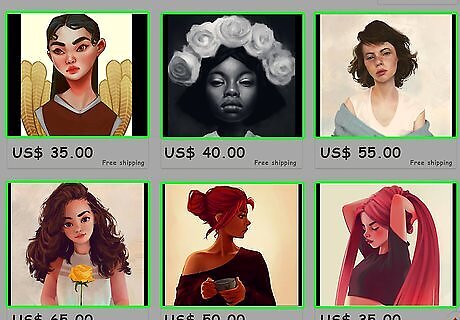
Keep the style of the shop cohesive and consistent. Make sure all of your pictures, icons, and text are consistent across your shop. Use the same font for all your text and check that your pictures all look uniform. This will help to make your shop look more legitimate to buyers. If you do decide to change or update your shop in any way, make sure you do it for the entire shop. This will ensure the shop stays cohesive.
Promoting and Marketing Your Artwork
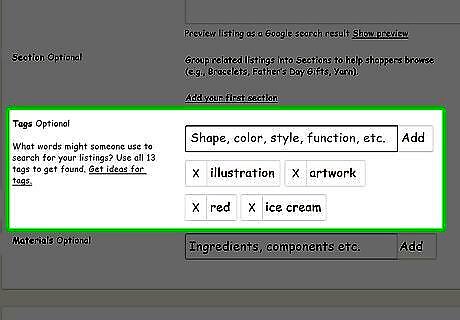
Put tags and keywords on your artwork. One of the key ways you can make sure your artwork shows up when buyers search for items on Etsy and search engines is by using tags and keywords. Use keywords like the type of art you are selling, such as “painting,” “print,” or “ceramic.” You can also use keywords or tags that relate to the medium and to key colors, such as “oil paint,” “collage,” “yellow” or “blue.” You can add tags by writing going to the Shop Manager page and then the Listings page. Find the item you want to tag and select "Edit." Then, scroll down to "Tags" and add tags to the item. Use Etsy’s search bar to look up popular tags and keywords. Then, add them to your listings so buyers can find your artwork easily. You may need to tweak your keywords and tags as you start selling your work in your shop. Over time, you should be able to find keywords and tags that relate to your work and are high on the search list.
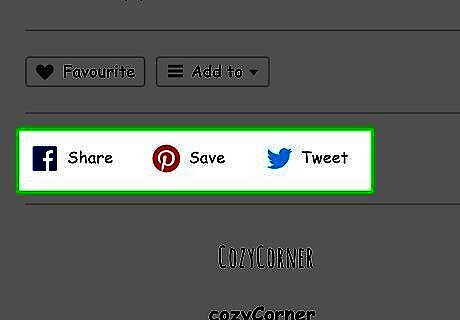
Promote your artwork on social media. Create social media accounts for your shop so you can post items on these accounts as well. You may make a Facebook page, a Flickr account, or an Instagram account for the shop. Then, cross-post items on social media and Etsy so you can reach more customers. Etsy has a "Share on Facebook" button on their site that you can use to easily cross-post items. Avoid posting every item on all your social media accounts, as your followers may not appreciate being marketed to all the time. Instead, try to spread out your posts and only post once a day or once every other day. For example, you may write a social media caption like, "Flash Sale on all Animal Cross Stitch" or "New artwork in the shop, come check it out!"

Create an email newsletter for the shop. Email newsletters can be a good way to let your followers and buyers know what’s new at your shop. Ask buyers to sign up for your email newsletter and put a call out on your social media. Then, blast out an email newsletter with updates and items for sale once a month. Keep your emails short, informative, and full of great images. Do not send email newsletters out too often, as they can become annoying for buyers. Once a month or several times a year is usually ideal.

Do interviews and blog posts to promote the shop. Get your shop some attention by contacting writers, editors, and bloggers in the art world to see if you can do an interview about your shop. You may also offer them free samples or exclusive access to your artwork in exchange for promoting your work to their users. Focus on bloggers and writers who you feel fit the aesthetic and style of your shop. This way, you can cater to users who might be interested in your artwork and want to buy it.
Maintaining Your Etsy Shop

Ship items with care. Once someone buys your artwork, you will need to package it and ship it so it gets to them safely. Package your artwork so it does not bend, chip, or break in the mail. Place prints and unframed artwork between cardboard or foam core. Use “Fragile” or “Do not bend” stickers and stamps. You can also use packing materials like peanuts and bubble wrap, as well as sturdy boxes, to ship items. You may add in the cost of packing materials to your shipping charges.
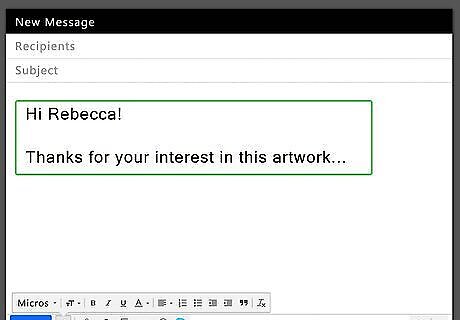
Provide personalized customer service. Give your customers the personal touch by responding to their messages and emails in a polite, friendly manner. Answer their questions promptly and clearly. Maintain a positive attitude when customers have questions or concerns. Being friendly and personal can make your customers want to buy from you and encourage them to leave positive reviews. For example, you may start every message or email with, “Hello!” or “Hi there!” You can also include the buyer’s name, if they included it in their message. You can also include a positive note like, “Thanks for your interest in this artwork” or “I appreciate your interest in this item.”

Encourage buyers to leave reviews. Some buyers will leave reviews without being prompted by you, as they are asked through Etsy to leave a review of their purchase. You can also send out messages to previous buyers asking them to leave a review for the item, as you would appreciate their feedback. Don’t take it personally if you get a negative review or a review that is not five stars. Be open to feedback and try to do better next time. You may decide to respond to a negative review to show your customers you care. Try to be diplomatic and friendly in your response.
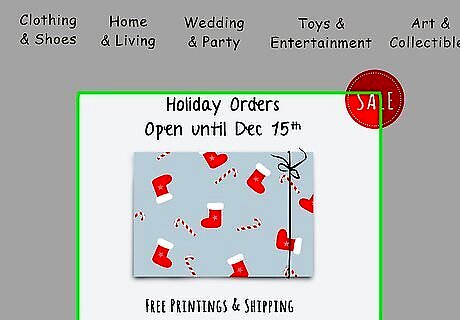
Stagger your artwork based on seasons and holidays. Keep your shop current by stocking artwork that corresponds to the seasons. Maybe you include holiday themed artwork in the months leading up to Christmas. Or perhaps you stock Halloween related artwork in September and October. This can encourage buyers to purchase from you. Keep in mind that if a listing does not sell within 4 months on Etsy, you will need to pay a small fee to keep it in your shop. Staggering your listings can help you to avoid stocking items that may not sell or be of interest to customers.

Keep your shop active and up-to-date. Stay active on your Etsy shop and put new stock up regularly. If you notice certain artwork is selling more, put more of it up in the shop. Move any items that are not selling off your shop or mark it on sale so you can sell them quickly. It may take some time for your Etsy shop to be profitable and find a customer base. Be patient and stay active on your shop so you can cultivate a strong presence on the site. Over time, you should be able to find a market for your artwork on Etsy.




















Comments
0 comment